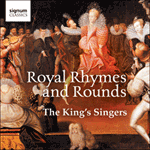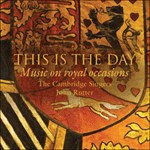
Welcome to Hyperion Records, a British classical label devoted to presenting high-quality recordings of music of all styles and from all periods from the twelfth century to the twenty-first.
Hyperion offers both CDs, and downloads in a number of formats. The site is also available in several languages.
Please use the dropdown buttons to set your preferred options, or use the checkbox to accept the defaults.

The set of six Choral dances from ‘Gloriana’ for unaccompanied chorus was first performed by the BBC Midland Chorus in a broadcast on 7 March 1954; the set was later rearranged to include tenor solo and harp obbligato for a performance to mark the opening of the Queen Elizabeth Hall, London, in 1967. The dances occur in the first scene of the opera’s second act, which portrays a colourful masque at Norwich’s Guildhall attended by Queen Elizabeth I during a royal progress. Britten had intended this scene to combine vivid pageantry with a homage to Elizabethan song and dance, but later felt that it impeded the dramatic flow of the opera as a whole, and in some later productions the entire scene was cut. The sequence begins with the appearance of the demigod Time, ‘lusty and blithe’, who is followed by his wife Concord. Her song is set to music made up entirely of concords, a deliberate witticism on Britten’s part. After Time and Concord have danced together, country girls, rustics and fishermen join in the celebrations before the concluding ‘Dance of homage’ to the visiting sovereign.
from notes by Mervyn Cooke © 2001
La première audition du recueil de six Choral dances from ‘Gloriana’ pour chœur seul fut donnée par le Chœur de BBC Midland lors d’une émission diffusée le 7 mars 1954. Le recueil fut ensuite remanié pour incorporer un solo de ténor et une harpe obligée à l’occasion de l’inauguration du Queen Elizabeth Hall, à Londres, en 1967. Tirées de la première scène du second acte de Gloriana, ces danses chorales dressent un portrait pittoresque de la représentation d’un «masque» bigarré se déroulant à la Guildhall de Norwich en présence de la reine Elisabeth I au cours d’un voyage royal. Dans cette scène, Britten avait souhaité joindre à un faste éclatant un hommage aux chansons et danses élisabéthaines. Par la suite, il eut l’impression qu’avec cette scène, c’était le déroulement de l’action dramatique de tout l’opéra qui marquait un temps d’arrêt, si bien qu’il l’omit des productions ultérieures. La séquence débute par l’entrée du demi-dieu Temps, «lusty and blithe» («vigoureux et joyeux») suivie de celle de son épouse Harmonie. Elle chante une mélodie où seules figurent des harmonies parfaites, un trait d’humour délibéré de la part de Britten. Puis, Temps et Harmonie dansent ensemble, rejoints par des jeunes filles, des paysans et des pêcheurs, puis les festivités prennent fin sur une «Danse d’hommage» à la souveraine.
extrait des notes rédigées par Mervyn Cooke © 2001
Français: Isabelle Battioni
Die sechs Choral dances from „Gloriana“ für unbegleiteten Chor wurden vom BBC Midland Chorus anläßlich einer Rundfunksendung am 7. März 1954 erstmals aufgeführt; die Zusammenstellung wurde später für eine Aufführung zur Eröffnung der Londoner Queen Elizabeth Hall im Jahr 1967 mit Tenorsolo und Harfen-Obligato neu bearbeitet. Die Tänze stammen aus der ersten Szene im zweiten Akt der Oper, die ein farbenfrohes Maskenspiel im Zunfthaus von Norwich darstellt, wo die Königin Elisabeth I. auf einer königlichen Rundreise zu Gast war. Britten hatte die Absicht, in dieser Szene buntes Gepränge mit einer Huldigung an elisabethanischen Gesang und Tanz zu verbinden, kam jedoch später zu der Ansicht, daß sie den übergreifenden dramatischen Fluß der Oper behinderte, und bei einigen späteren Inszenierungen wurde die ganze Szene gestrichen. Die Sequenz beginnt mit dem Auftritt des Halbgottes Time („Zeit“), der als „stramm und unbekümmert“ beschrieben wird, gefolgt von seiner Gemahlin Concord („Eintracht“). Ihr Lied ist mit Musik unterlegt, die ausschließlich aus Konkordanzen besteht, ein geistreicher Einfall Brittens. Nachdem Time und Concord miteinander getanzt haben, beteiligen sich Landmädchen, Bauernburschen und Fischer an den Feierlichkeiten, ehe der abschließende „Dance of homage“ dem königlichen Gast huldigt.
aus dem Begleittext von Mervyn Cooke © 2001
Deutsch: Anne Steeb/Bernd Müller
 Royal Rhymes and Rounds Royal Rhymes and RoundsIn the occasion of 2012 Diamond Jubilee, The King's Singers presented a selection of works from the past 500 years written in honour of the great Monarchs of Britain. Starting with works for Henry VIII, the programme covers the Elizabethan Triumph ...» More |
 This is the day This is the dayThis album recollects and celebrates some of the choral music heard on royal occasions during the lifetime of HM Elizabeth II. The music chosen reflects the personal choices and commissions by the Royal Family for weddings, funerals, and anniversa ...» More |

